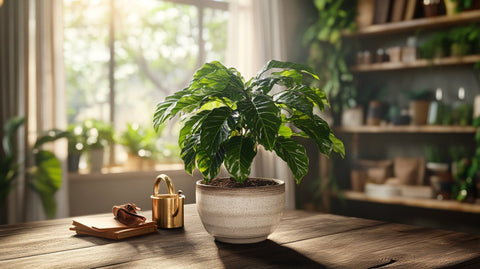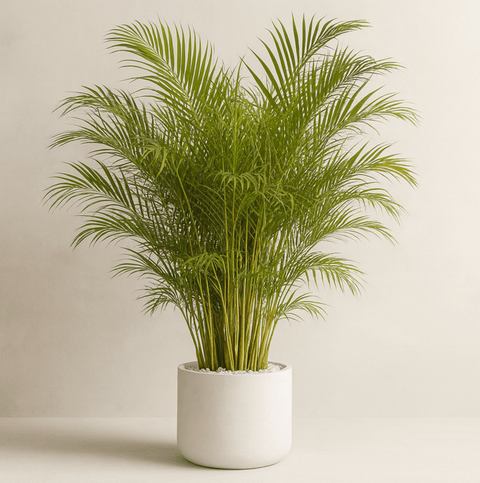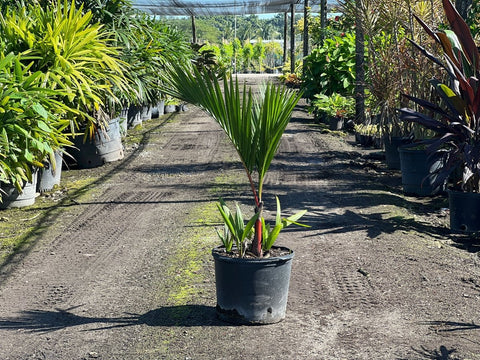Introduction
The Arabica coffee plant is not just an iconic symbol in the world of caffeinated beverages but also an enchanting addition to any home or garden. Known for producing nearly 60% of the world's coffee, Arabica is celebrated for its smooth, nuanced flavor profile. Its journey from the lush highlands of Ethiopia to your coffee mug is a remarkable tale of botanical and cultural evolution. Paradoxically, while most enjoy the fruits of this plant in brewed form, fewer are familiar with its cultivation and care. This blog sheds light on nurturing the exquisite Arabica coffee plant so you can bring an authentic slice of nature's brilliance into your space.

Understanding the Arabica Coffee Plant
A. Characteristics of Arabica Coffee
Origin and Natural Habitat
The Arabica coffee plant (Coffea arabica) is indigenous to the Ethiopian highlands. Historically, it thrived in the shaded forests of Africa, where it naturally evolved to prefer subtle dappled light and rich, loamy soil. In its native environment, the plant grows as an understory shrub or small tree amidst larger canopy trees, which protect it from direct sunlight, allowing the coffee to develop its characteristic flavors slowly.
Physical Description: Leaves, Flowers, and Cherries
The Arabica coffee plant features glossy, dark-green leaves that offer year-round visual appeal. These elliptical leaves are both striking and functional, forming a dense canopy that shields the plant's delicate blooms. The blossoms of the Arabica coffee are small, white, and fragrant, resembling jasmine in scent. These flowers eventually give rise to the coffee cherries, small stone fruits that turn deep red or purple when ripe. This brilliant transition not only signifies readiness for harvest but also adds a vibrant splash of color to any setting.
B. Importance in the Coffee Industry
Arabica coffee holds a place of prestige in the coffee industry due to its superior taste and aroma compared to robusta, its major commercial counterpart. Arabica beans are known for their smoothness, mild acidity, and variety of flavor notes, including fruits, nuts, and even floral hints. Such qualities have entrenched Arabica's dominance as the coffee bean of choice in premium blends and artisanal brews. As a home grower, nurturing your own Arabica plant not only elevates your gardening repertoire but also offers the unique reward of crafting a coffee experience from seed to cup.
Optimal Growing Conditions for Arabica Coffee Plants
A. Climate and Temperature
For thriving health, Arabica coffee plants require a climate akin to their native tropical highlands, which entails mild temperatures ranging from 60 to 70 °F (15 to 24 °C). While these plants can tolerate slightly higher or lower temperatures, extreme heat or frost can lead to stress and adversely affect growth and yield. If growing Arabica indoors, ensure a stable room temperature and avoid placing the plant near drafty windows or heating elements.
B. Soil Requirements
Arabica coffee plants flourish best in well-draining, slightly acidic soil with a pH of 6 to 6.5. The ideal soil composition includes rich organic matter, which not only supports robust growth but also facilitates proper drainage. Consider adding peat moss or a specialized plant medium, such as the one we offer for exotic plants at Plantology, to enhance soil quality. This will provide your Arabica coffee plant with the nourishment it needs to produce lush foliage and succulent cherries.

C. Light Requirements
Replicating the Arabica plant's natural understory conditions is crucial for optimal light exposure. These plants prosper in filtered or indirect sunlight. Direct sunlight can scorch the leaves and reduce productivity, so position your plant near a north or east-facing window. For hotter climates, introducing a sheer curtain or moving the plant slightly away from strong afternoon sun will help maintain its health.
Watering and Feeding Your Arabica Coffee Plant
A. Watering Guidelines
Consistent and moderate watering is key to sustaining an Arabica coffee plant. These plants prefer moist, but not saturated soils. Water the plant thoroughly, allowing excess water to drain fully. Ensure the top inch of the soil dries out between waterings to prevent root rot. Adjust your watering schedule according to seasonality, reducing frequency during the cooler months when the plant’s growth naturally slows.
B. Fertilization Needs
To support vibrant foliage and fruiting, Arabica coffee plants benefit from regular feeding. Use a balanced, slow-release fertilizer every 6 to 8 weeks during the growing season. Our selection of organic fertilizers at Plantology is especially formulated for acid-loving plants, ensuring your coffee plant receives all the necessary nutrients without the risk of chemical buildup.
Propagation and Transplanting Techniques
A. Propagation Methods
From Seeds
Propagating Arabica coffee plants from seeds involves selecting ripe coffee cherries, extracting and cleaning the seeds, and placing them in a nutrient-rich, well-draining starting medium. Germination can take up to six months, and success is typically higher when seeds are fresh.
From Cuttings
Alternatively, plant lovers may opt to propagate Arabica plants through cuttings. Select healthy, semi-ripe cuttings approximately 4-6 inches long. Remove lower leaves and dip the cut end in rooting hormone before planting in a starter medium. Maintain high humidity by covering the cutting with a plastic bag, ensuring air circulation to prevent mold growth.

B. Transplanting Guidelines
As your coffee plant matures, repotting becomes necessary to ensure it has ample space for root expansion. Transplant the plant to a larger container with fresh soil, taking care to handle the root system gently. Perform this task during the plant’s dormant period to minimize transplant shock and support smooth acclimatization.
Common Challenges and Troubleshooting
A. Pest Management
Arabica coffee plants are susceptible to a few notable pests, chiefly among them being aphids and spider mites. Regularly inspect your plants for these invaders. Our Plantology organic insecticidal soap is an effective treatment that is gentle on plants while eliminating pests. Act proactively to minimize infestations and prevent larger issues.
B. Disease Prevention
Fungal infections such as leaf spot diseases can occasionally afflict Arabica coffee plants, typically resulting from excessive moisture or poor airflow. Ensure good airflow around the plant, avoid overhead watering, and remove any diseased leaves immediately to prevent the spread of infection.
C. Leaf Spot and Rot Solutions
For issues like leaf spot or root rot, it is paramount to alter watering practices and remove affected plant material. Use a fungicidal spray from our Plantology lineup for robust protection against further fungal intrusion, safeguarding the future health of your Arabica coffee plant.

Conclusion: Cultivating Arabica Coffee at Home
By understanding the specific needs of the Arabica coffee plant, enthusiasts can transform their homes into vibrant havens of coffee culture. From selecting the right light and soil conditions to mastering advanced care techniques, each step plays a vital role in the health and prosperity of your plant. At Plantology, we are dedicated to assisting our community in achieving these horticultural feats. Explore our curated selection of fertilizers, care products, and expert guidance, all designed to empower you in your gardening journey.
For a seamless start to your indoor plant collection, consider pairing your Arabica coffee plant with another exotic offering from our catalog. Check out our stunning Adonidia Palm – Double or the graceful Agapanthus Lily of the Nile – Blue. Each species offers unique beauty and harmonizes splendidly with the lush, verdant aesthetic of your coffee plant.
Advanced Care Techniques for Increased Yield
A. Pruning for Health and Productivity
Pruning is an essential practice for maintaining the health and productivity of your Arabica coffee plant. Regular pruning encourages better air circulation and light penetration, essential for growth and disease prevention. Focus on removing dead or diseased branches, and trim back overgrown limbs to maintain a balanced shape. Pruning should be performed during the plant's dormant season to minimize stress and promote vigorous regrowth.
When pruning, use sharp, sterile tools to make clean cuts just above a node. Start by removing any suckers – these are small shoots that can divert energy from the main plant. You can also thin out the inner branches to open up the center of the plant, reducing humidity and deterring pests.
B. Formative Pruning for Indoor Gardening
Formative pruning is particularly impactful for indoor growers, where space can be limited. By training your coffee plant early, you can shape its growth habit to suit your environment. Consider guiding branches to grow more horizontally when growing under artificial lights to take full advantage of the light source. Establish a structure for your plant that supports both aesthetics and functionality, ensuring optimal health and a prolific yield.
C. Supporting Fruit Development
After flowering, fruit development is the next critical stage. To support this process, be diligent about your plant's nutritional needs. Potash-rich fertilizers can help in setting fruit and development. Consistently monitor flowers for completion of pollination, and where feasible, gently shake the plant to facilitate the process.

Integrating Arabica Coffee Plants into Landscape Design
A. Aesthetic Contributions
Beyond its practical uses, the Arabica coffee plant can play a beautiful role in landscape design. Its glossy leaves and vibrant red cherries create an appealing contrast when paired with other ornamental plants. Use them as focal points or accents in borders, combined with ferns or shady perennials, to enhance the exotic allure.
Layering coffee plants into mixed planters can also impressively diversify visual textures and dynamics. Their structured growth habit holds formality, just as annuals provide seasonal color, enriching the composition with year-round interest.
B. Companion Planting
Companion planting with Arabica coffee plants can enhance biodiversity and cultivate a beneficial ecosystem in your garden. Consider pairing your coffee plant with nitrogen-fixing plants like peas or beans, which enrich the soil. These crops can often divert pests from the coffee plants, creating a reciprocal protective relationship.
For those seeking additional visual interest, flowering plants such as bivavaria or alyssum can attract natural pollinators, further enhancing fruit set and health. Assess the environmental requirements of potential companions to ensure harmony and support optimal coffee tree growth.
Harvesting and Processing Arabica Coffee
A. Recognizing Ripe Cherries
Recognizing the perfect time to harvest your coffee cherries is key. Arabica cherries are ready to be harvested when they reach a deep, vibrant red or purple, signaling their sweetness and full flavor profile. Typically, this occurs about 7-9 months after flowering, depending on growing conditions and climate.
B. Hand-Picking Techniques
Hand-picking is the preferred method for home growers, allowing precise selection of ripe cherries and preserving the health of the plant. Handle the fruit delicately to avoid any unnecessary damage. Once collected, the cherries should be processed swiftly to capture their freshness.
C. Processing Methods
Processing is where magic happens, transforming ripe cherries into aromatic coffee beans. The two primary methods are the dry (natural) process and the wet (washed) process. The natural process involves spreading cherries in a thin layer under direct sunlight, regularly turning them to ensure even drying until the beans separate from the skin.
For a more traditional flavor profile, the washed process may be favored. This involves depulping cherries before they are fermented in water tanks to remove mucilage, giving rise to a cleaner bean finish. Whether using your kitchen or backyard setup, each method presents unique flavors and complexities in your cup.

Crafting the Perfect Brew at Home
A. Roasting Basics
The roasting process is what defines the aroma and flavor of your coffee. Once your beans are fully dried or processed, roasting can be done in a conventional oven or a specialized roaster. Start with a light roast to preserve intricate flavor profiles, adjusting based on personal preference as you refine your technique.
The visual cues during roasting provide invaluable information. Watch for a noticeable change in color and aroma, as well as the first 'crack' indicative of beans progressing through stages. Practice will yield improvements in achieving a consistent roast, crucial for reproducing the perfect brew each time.
B. Grinding and Brewing
The grind size plays a pivotal role in extraction and flavor. A medium grind suits auto-drip coffee makers, while a finer grind is ideal for espresso machines. For French press enthusiasts, a coarse grind offers the best brew. Experiment with grind settings and carefully calibrate based on your preference to find the ideal cup profile.
Utilize fresh, filtered water heated to about 195-205°F (90-96°C) to extract the perfect cup. Be precise with water measurements to balance the body and strength. Whether using a pour-over method, French press, or espresso machine, follow optimal brew times to enhance the full flavor spectrum of your home-grown coffee.
Sharing the Arabica Experience
A. Creating Community Connections
Coffee culture thrives on community. Share your new expertise and experiences of growing and brewing with friends and family. Host coffee tastings or educational workshops to engage others in the exciting journey from plant to cup. Sharing samples of your homegrown beans fosters connections, cultivates shared experiences, and spreads appreciation for the coffee art form.
B. Contributing to Sustainable Practices
By growing your own Arabica coffee plant, you are joining a global movement towards sustainability and mindful consumption. Focus on using organic practices and recycled materials to minimize your environmental impact. Share insights into sustainable practices with the broader community, encouraging responsible and eco-conscious cultivation.

Conclusion and Future Ventures
Cultivating and enjoying your own Arabica coffee plant is a rewarding journey that extends beyond simple gardening. From understanding its rich history and precise care requirements to mastering the steps toward the perfect brew, each stage brings newfound appreciation for this remarkable plant. As you continue this vibrant journey, consider expanding your horticultural expertise by exploring new plants and diversifying your indoor garden.
At Plantology, we remain dedicated to supporting gardeners of all levels with the tools and knowledge needed to thrive. Whether you are looking to venture into new botanical territories or expand your existing coffee collection, our resources are here to guide you along the way. Embrace this interactive relationship with nature, and redefine what it means to enjoy coffee in every essence and intricacy.
Join our vibrant community at Plantology and share your gardening milestones with us. We are eager to celebrate your successes, offer guidance, and together explore the boundless world of plants. Discover a deeper connection to your coffee and your garden, where living sustainably becomes a fulfilling and shared journey.























Comments (0)
There are no comments for this article. Be the first one to leave a message!